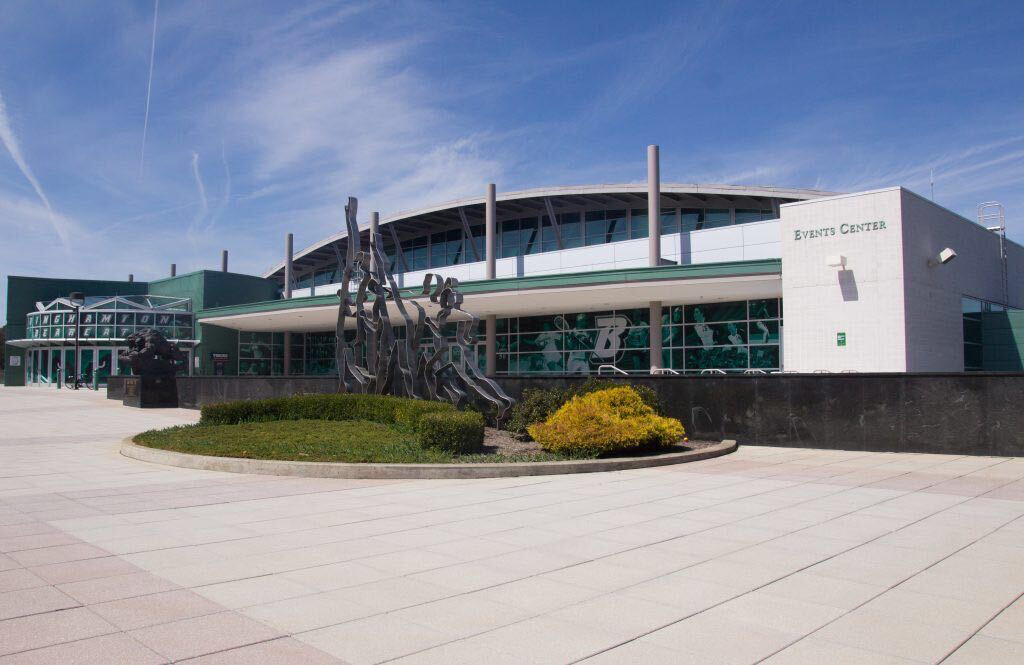The year 2020 will forever be known as the year when nearly the entire country came to a pause because of the COVID-19 pandemic. Everyone will remember the week in March when everything shut down and most Americans were unable to leave their homes. College athletics was no exception, as NCAA winter and spring seasons were canceled for the year.
“Everything changed on March 12,” said Binghamton Director of Athletics Patrick Elliott. “I didn’t think I’d ever see the day that we’d be canceling the winter sport championships, the Final Four, the spring sports championships.”
When the cancellation occurred, and for the following couple of months, it didn’t cross anyone’s mind that the virus would have an effect on fall sports. According to Elliott, the America East’s (AE) athletics directors met twice a week to discuss the upcoming fall season and how it would be conducted under the new normal, and the idea that the fall season would need to be shelved was not entertained initially.
“We kind of always had this expectation that, hopefully by July, things would calm down with the virus, that the numbers would decrease, that the testing would increase and that there might also be some other therapeutic drugs on the market, but I think the opposite happened,” Elliott said. “So when we got into the beginning of July, I think it became evident that we were really trying to thread a needle.”
Some of the many topics discussed in these meetings were how to provide adequate testing for athletes and how to deal with travel restrictions across state lines. The conference considered different scheduling models in an attempt to fit the season in, but as July went on and as meetings between the AE Board of Presidents and AE Commissioner Amy Huchthausen occurred, it became evident to all that the fall season could not be safely conducted. All of this led to the July 17 announcement that the AE would postpone its fall sports season until the spring.
The AE became one of the first conferences in the country to make the move to postpone fall sports. The Ivy League and the Patriot League suspended fall sports earlier in July and the Atlantic 10 suspended its fall season the same day as the AE. There was a lot of difficulty associated with the AE’s decision, but, according to Elliott, one of the most difficult aspects was informing the fall student-athletes.
“The morning of the announcement, I had a Zoom call with all of the fall student-athletes, and it was really difficult,” Elliott said. “I had been conducting calls with our student-athletes all summer, with various teams, just to try to give them updates. I spoke to the athletes, I explained to them how the decision was made. The only glimmer of light is that at that point in time we were pushing for having a spring season, and that’s still the case.”
According to Elliott, the NCAA Board of Governors voted recently to hold fall championships in the spring. The NCAA has yet to release the dates for these championships, but once it does, the AE will work backward from there to determine its schedule for the spring. Elliott does not foresee any issues at BU with holding fall and spring sports at the same time.
“Men’s and women’s lacrosse, we typically start that up in February,” Elliott said. “My guess is that we’re probably going to be starting soccer a little bit later than that, maybe in March. With lights on the field, we won’t have a problem with those fall sports.”
The AE plan for fall sports allows fall teams to train and practice. According to Elliott, the athletics department has developed a set of protocols with the Broome County Health Department and the department’s physicians, all in accordance with NCAA guidelines.
About one in five BU athletes was required to quarantine for two weeks upon arrival on campus due to New York state rules. All others were given an antigen COVID-19 test upon arrival. Prior to undergoing routine physicals, all athletes will be given a PCR test for COVID-19. Once athletes clear both of those exams, the department’s strength and conditioning coaches will take over to increase the athletes’ fitness levels.
“After our athletes are medically cleared, then our strength and conditioning coaches will look at varying fitness levels and range of motion and things like that, because this is probably the first time in a long time for these athletes that they’ve had so much noncompetitive time,” Elliott said. “For the most part, most of them haven’t been able to get into gyms or play summer leagues, so we want to be really up front and cautious about that.”
According to Elliott, the tests that will be administered will allow the department to compare test results for different groups and teams and look at varying levels of positivity rates. This will help with the department’s goal of controlling the spread of the virus within the department to the greatest extent possible.
“What we’re trying to do is bring everybody back, stop the spread of COVID-19 within the athletics department and then make sure that, from a physical perspective and from an orthopedic perspective, our student-athletes ramp up their conditioning to where they’re ready to play,” Elliott said.



